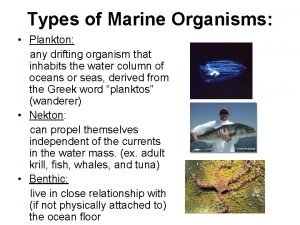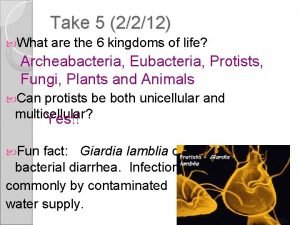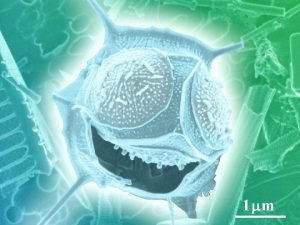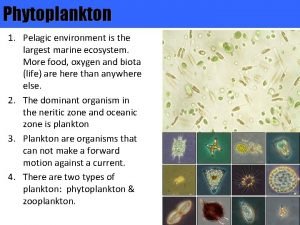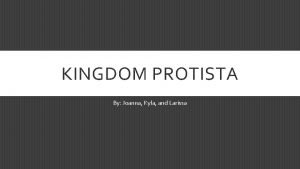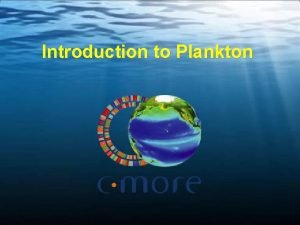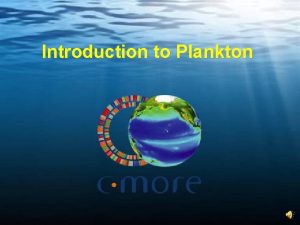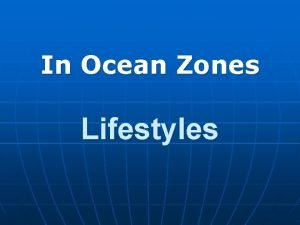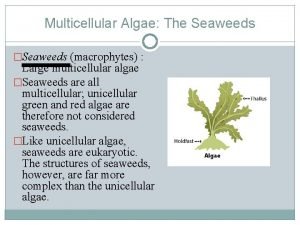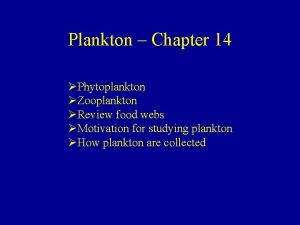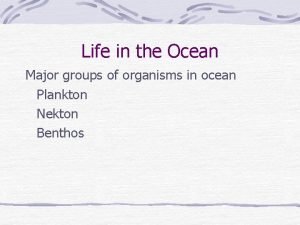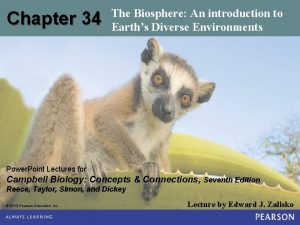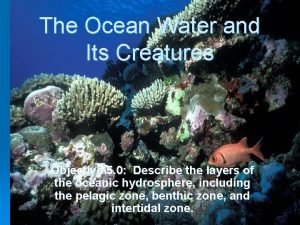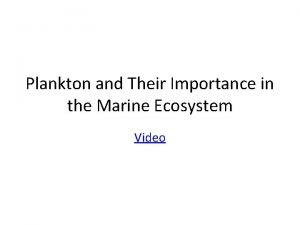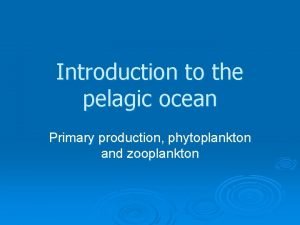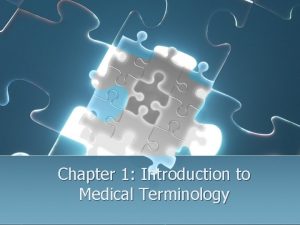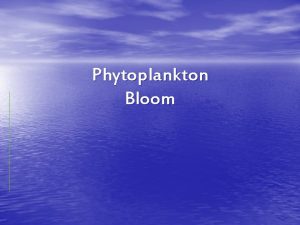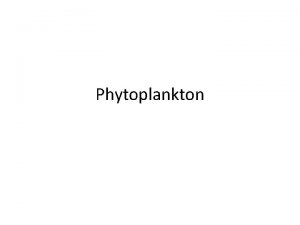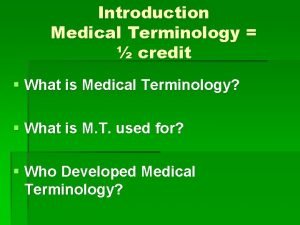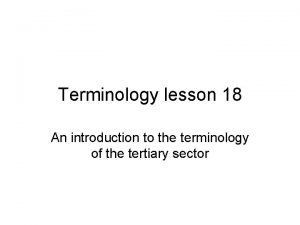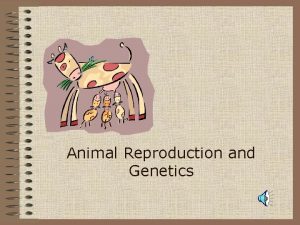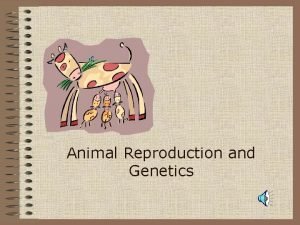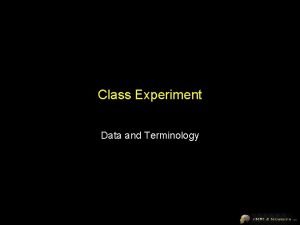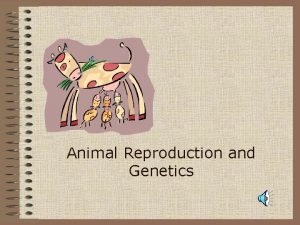Lecture 2 Terminology and Introduction to Phytoplankton Introduction



































- Slides: 35

Lecture 2: Terminology and Introduction to Phytoplankton Introduction to Biological Oceanography 2004

Terminology and Scales

Plankton “wandering” or “drifting” (incapable of sustained, directed horizontal movement)

www. shellbackdon. com Nekton Active swimmers

Components of the Plankton Virioplankton: Viruses Bacterioplankton: Bacteria — free living planktobacteria; epibacteria attached to larger particles Mycoplankton: Fungi Phytoplankton: Photosynthetic microalgae, cyanobacteria, and prochlorophytes Zooplankton: Heterotrophic — Protozooplankton (unicellular) and Metazooplankton (larval and adult crustaceans, larval fish,

Components of the Plankton Ichthyoplankton: Planktonic fish (generally, eggs and larval stages) Meroplankton: Planktonic organisms that have a sedentary stage. For example, phytoplankton with resting stages in sediments Holoplankton: Wholly planktonic

Components of the Phytoplankton: Older scheme Netplankton: Inspecting a small plankton net. In: "From the Surface to the Bottom of the Sea" by H. Bouree, 1912, Fig. 49, p. 61. Library Call Number 525. 8 B 77. Plankton that is retained on a net or screen, usually 20 100 µm Nanoplankton: Plankton that passes the net, but which is > 2 µm Ultrananoplankton: Plankton < 2µm

Components of the Plankton (older scheme) Netplankton: Plankton that is retained on a net or screen, usually 20 - 100 µm Nanoplankton: Plankton that passes the net, but which is > 2 µm Ultrananoplankton: Plankton < 2µm Microzooplankton: Zooplankton in the microplankton (i. e. , < 200 µm)

Length Scales to Define Plankton Groups Sieburth, J. M. , Smetacek, V. and Lenz, J. (1978). Pelagic ecosystem structure: Heterotrophic compartments of the plankton and their relationship to plankton size fractions. Limnol. Oceanogr. 23: 1256 -1263.

Terminology and Scales: SI Units FRACTION PREFIX SYMBOL EXAMPLE 10 -1 deci d decimeter, 10 cm, length of a planktivorous fish 10 -2 centi c 1 centimeter, diameter of a ctenophore 10 -3 milli m 1 millimeter, length of a copepod 10 -6 micro µ 1 micrometer, diameter of a very small phytoplankter or a large bacterium 10 -9 nano n 1 nanogram, weight of a fairly small phytoplankter 10 -12 pico p 1 picogram, chlorophyll content of one small phytoplankter 10 -15 femto f 1 femtogram, amount of ATP in a phytoplankter 10 -18 atto a att’s a small number!

Scales: The ocean is a dilute environment!

Characterizing Constituents of the Water Detritus: Matter of organic origin, but incapable of reproduction (dead) Seston: All suspended particulate matter Tripton: The non-living part of seston DOM: Dissolved organic matter (passes a fine filter) CDOM: Chromophoric (colored) DOM Neuston: Inhabiting the surface layer Allochthonous: Developed or originating from elsewhere Autochthonous: Endemic: originated locally

Characterizing Environments Euphotic Zone: Surface layer, to the depth where positive net photosynthesis is no longer possible (compensation point) Often defined as the zone that extends from the surface to the depth at which light is reduced to 1% of its surface value (sometimes 0. 1% light level is used). This is arbitrary and unnecessary — the 1% light depth is much better lit at the equator than at high latitudes in winter on a cloudy day! May occur at depths exceeding 100 m in oligotrophic open-ocean waters or it may be less than 10 m in eutrophic or turbid waters Compensation Irradiance = 22 µmol m-2 s-1

Characterizing Environments Eutrophic: Refers to the level of nutrients hypereutrophic > mesotrophic > oligotrophic Oceanic: Open ocean, water depth > 200 m Neritic: Beyond low water out to the edge of the shelf (i. e. , depth < about 200 m) Pelagic: Includes both oceanic and neritic

Modes of Nutrition Autotrophic: No material of organic origin is required for growth and reproduction Auxotrophic: Physiological requirement for one or more organic compounds, but C is obtained autotrophically Heterotrophic: Growth depends on organic material Mixotrophic: Autotrophic and heterotrophic nutrition Photosynthetic mixotrophs can consume organic matter by phagotrophy (engulfing particles) and osmotrophy (uptake of dissolved organic materials)

Important Questions in Biological Oceanography How much is there? Primary Standing Crop Instantaneous value of the amount of living plant material present in the water (g m-3 or g m-2) “Material” can be expressed in terms of many substances, but organic carbon is fairly well accepted as the preferred measure of biomass for field applications (phytoplankton carbon can not be measured directly, though, because of detrital component of POC [particulate organic carbon]). Chlorophyll a is a highly variable index of phytoplankton biomass.

Important Questions in Biological Oceanography How fast is it being produced? Net Primary Productivity (Production) Net rate of synthesis of organic material from inorganic compounds such as CO 2 and water Chemosynthesis: chemical reducing power comes from reduced inorganic compounds such as H 2 S and NH 3 Photosynthesis: reducing power comes from light energy Photosynthetic primary production is usually measured and considered to dominate. g C m-3 h-1 g C m-2 d-1

Important Questions in Biological Oceanography How fast is it being produced? Secondary Production: Net rate of synthesis of organic matter resulting from the assimilation of organic compounds supplied by primary production Examples: Herbivores eat phytoplankton; their growth is secondary production Heterotrophic bacteria assimilate compounds released from phytoplankton; this is also secondary production Tertiary production: follows the same line of reasoning. Existence of detritovores, omnivores, mixotrophs makes for complicated relationships

Phytoplankton - autotrophic P. Roger Sweet, Indiana University Diatoms www. whoi. edu/redtide/rtphotos/ Dinoflagellates Photosynthesis

Why is phytoplankton ecology important? Phytoplankton provide the basis for most marine food webs

Ecosystem Net Primary Total Biomass Turnover Productivity (1015 grams) Time (years) (1015 grams/year) Marine 35 -50 1 -2 0. 02 -0. 06 Terrestrial 50 -70 600 -1000 9 -20

Harmful Algal Blooms Fish Kills From GEOHAB Science Plan and http: //europa. eu. int/comm/research/rtdinfsup/en/world 4. htm Shellfish Toxicity European Commission - Ocean Research - The balance of living organisms Noxious foams or scums

Diatom Brown algae


Chlorophyll pigment is often equated with phytoplankton biomass • Phytoplankton pigments influence ocean color

All phytoplankton were not made equal. . . • Even though phytoplankton are often considered as light absorbers, packages of pigment, or organic particles, they are biologically very diverse - Phylogenetic - Metabolic - Habitat/Niche Space

Light energy is collected by photosynthetic pigments All plants have chlorophylls and carotenoids Some groups (cyanobacteria, cryptophytes, red algae) have phycobiliproteins Pigments are used to infer species composition Pigmentation varies with growth conditions

PHYTOPLANKTON Procarya Eucarya (cyanobacteria (i. e. , Synechococcus, Prochlorococcus), (Cryptophyceae, N 2 fixers (i. e. , Trichodesmium)) Dinoflagellates, Diatoms, Coccolithophores, Phaeocystis, Chattonella )

The Taxonomic Groups of Phytoplankton: An Overview 1. Bacteria (prokaryotes) • • • Eubacteria (heterotroph) Archebacteria or Archaea (heterotroph) Cyanobacteria (phototroph) – "real Cyanobacteria" • filamentous cyanobacteria, fix nitrogen • coccoid cyanobacteria – Prochlorophytes (recently made a new division) 2. Algae (eukaryotes) • Chromophyta (possess chl a and c) – Cryptophyceae – Dinophyceae – Chrysophyceae – Prymnesiophyceae – Bacillariophyceae (diatoms) – Raphidophyceae • Chlorophyta (possess chl a and b) – Chlorophyceae – Prasinophyceae – Euglenophyceae The taxonomic composition of phytoplankton does matter. . .

Phylogenies are under constant revision For our purposes, the older classifications are still useful http: //tolweb. org/tree? group=Stramenopiles&contgroup=Eukaryotes Page copyright © 1995 Mitchell L. Sogin and David J. Patterson

OLDER SCHEMES SERVE A PURPOSE Jeffrey and Vesk UNESCO volume

PROKARYOTES without a true nucleus Cyanobacteria: – Also called blue-green algae – Major accessory pigments: phycoerythrin, zeaxanthin - Synechococcus - Prochlorococcus

PROKARYOTES (continued): Synechococcus • • • Discovered in 1979 very small (ca. 1 µm) contains phycoerythrin can fluoresce orange or red counted with epifluorescence microscopy or flow cytometry http: //www. woodrow. org/teachers/esi/1999/ princeton/projects/cyanopigs/data. htm reprinted from Johnson and Sieburth 1979

PROKARYOTES (continued): Prochlorococcus • • Discovered in 1988 Very small (<1. 0 µm) Divinyl chl a Counted by flow cytometry • Most abundant autotroph on earth reprinted from Johnson and Sieburth 1979

PROKARYOTES (continued): Trichodesmium (Oscillatoria thiebautii) • • Forms aggregates Fixes nitrogen Can migrate vertically May transport phosphate from depth to near surface • New production transports more C www. aims. gov. au/pages/research/ trichodesmium/tricho-01. html http: //www. botan. su. se/fysiologi/Cyano/Tricho. jpg Trichodesmium bloom
 Rosa rigosa
Rosa rigosa The holdfast of brown algae functions in __________.
The holdfast of brown algae functions in __________. Pelagic phytoplankton
Pelagic phytoplankton Photosynthetic phytoplankton
Photosynthetic phytoplankton Animal like protists
Animal like protists Where do phytoplankton live
Where do phytoplankton live Phytoplankton examples
Phytoplankton examples Hadopelagic
Hadopelagic Chlorella is unicellular or multicellular
Chlorella is unicellular or multicellular Angonium
Angonium Where do you find phytoplankton
Where do you find phytoplankton Zooplankton
Zooplankton Is a starfish a plankton nekton or benthos
Is a starfish a plankton nekton or benthos Oscillatoria
Oscillatoria Biosphere
Biosphere Phytoplankton zooplankton
Phytoplankton zooplankton Phytoplankton zooplankton
Phytoplankton zooplankton Phytoplankton zooplankton
Phytoplankton zooplankton Pelagic phytoplankton
Pelagic phytoplankton Whales food chain
Whales food chain 01:640:244 lecture notes - lecture 15: plat, idah, farad
01:640:244 lecture notes - lecture 15: plat, idah, farad Introduction to biochemistry lecture notes
Introduction to biochemistry lecture notes Introduction to psychology lecture
Introduction to psychology lecture Introduction to algorithms lecture notes
Introduction to algorithms lecture notes 1/52 medical terminology
1/52 medical terminology Cyan medical term example
Cyan medical term example Chapter 4 introduction to medical terminology
Chapter 4 introduction to medical terminology Chapter 1 introduction to medical terminology
Chapter 1 introduction to medical terminology Chapter 1 introduction to medical terminology
Chapter 1 introduction to medical terminology Rhinoalgia
Rhinoalgia Introduction to veterinary terminology
Introduction to veterinary terminology Electricity and magnetism lecture notes
Electricity and magnetism lecture notes Power system dynamics and stability lecture notes
Power system dynamics and stability lecture notes Microbial physiology lecture notes
Microbial physiology lecture notes Limits fits and tolerances
Limits fits and tolerances Parallel and distributed computing lecture notes
Parallel and distributed computing lecture notes
